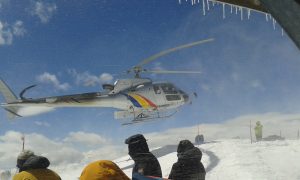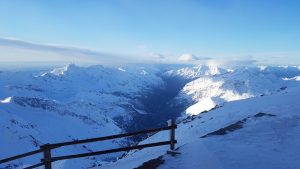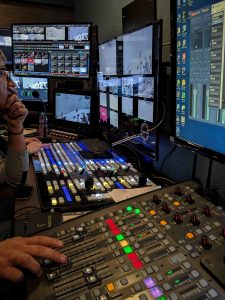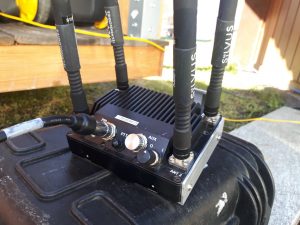Mountain marathon: Capturing Mezzalama Trophy Alpine action at over 4000 metres
The Mezzalama Trophy 2019 ski mountaineering marathon in the Italian Alps was postponed for four days due to adverse weather conditions, taking place eventually on Sunday 28 April. The Mezzalama, the last race of the season on La Grande Course ski-mountaineering circuit, started from the centre of Breuil-Cervinia and finished in Gressoney-La-Trinité.
 The historic race, first held in 1933, is the only one in the world that is raced over glaciers; it traverses two 4000ers, the Castor peak (4226 metres) and the Naso del Lyskamm pass. The event was followed by cameras that captured the spectacular images for Facebook Live and YouTube, plus a summary of the key phases was transmitted by Eurosport.
The historic race, first held in 1933, is the only one in the world that is raced over glaciers; it traverses two 4000ers, the Castor peak (4226 metres) and the Naso del Lyskamm pass. The event was followed by cameras that captured the spectacular images for Facebook Live and YouTube, plus a summary of the key phases was transmitted by Eurosport.
The organisation that takes care of the event, the Mezzalama Foundation, was among the first to create a live streaming service in 2011 and is still committed to creating a live broadcast for this important event. A production company from Trento, GiuMa Produzioni, took care of the artistic and technical realisation, relying on MediaNews production equipment.
The layout: wireless IP system and NDI production
Two cameras and a commentary journalist were connected live from the Quintino Sella refuge, which is at an altitude of 3585 metres and is situated nine kilometres away from the OB van gallery, located at the finish line in Gressoney. In the finish area there were three JVC cameras, one operating with a radio link and two on a tripod.
The point-to-point IP connection was made with a combined Silvus Technologies radio system supplied by Adcom Srl that also allowed the live intercom and the distribution of mix minus audio signals. The whole event was managed with IP technology, in order to help simplify all the coordination between the conductors in Gressoney and the one at the refuge, with video, audio and service communications.
The wireless system adopted also avoided the use of the telephone for the commentator – and the same

Mountain view looking towards Gressoney-La-Trinité
system was used for shooting from the helicopter. All video signals arrived at the mobile vehicle with low latency H265 feeds, thanks to Vitec devices, then decoded into NDI by NC1 I/O NewTek equipment. The gallery — made up of a MediaNews OB van — is built around NewTek equipment and operates entirely in IP (NDI). This made it possible to create a three-and-a-half hour TV broadcast with three camera streams in the finish area without problems.
The coverage range of the helicopter was several kilometres and the Silvus antennas at the refuge and on the finish line created a perfect mesh net; in fact, as soon as the helicopter intercepted the radio signals it was immediately on the net. This allowed the team to have two-way audio and to manage the production in an unconventional way, making the most of the IP network.
Roberto Musso of MediaNews said: “We were able to manage everything — audio, video, intercom, etc. — completely avoiding conversions and connections, and were able to have the necessary remote devices online.
“The Mezzalama is one of the most famous alpine skiing competitions in Europe covering 40 kilometres on foot, with skis on the feet, downhill, with crampons, descending a 3,000-metre slope and involving 900 super athletes from all nations.
“Managing a production that reaches 4500 metres and involves delicate safety issues is very complex and requires a very large deployment of forces. The result for the organisers is exciting with over 22K views on YouTube and 41K on Facebook Live, and the impact of being able to have a live helicopter really allowed us to offer stunning images. The situation was really extreme,” he added, “as we were working with temperatures at the refuge of -12° and from 60 to 90 km per hour winds.”
Mountain sport production with GiuMa and MediaNews
GiuMa is the production company that managed the realisation of this sports programme. Mario Barberi, one of the partners, told SVG Europe: “We are a small but very active production company, specialised in everything related to the mountain environment and therefore also mountain sports. We have been operating from Trento since 2013 and we also produce a lot of documentaries as well as the Mezzalama Trophy.”

Production gallery in the MediaNews OB van, built around NewTek NDI IP
Barberi continued: “The Mezzalama Trophy is not a simple race to organise and to follow from the media point of view. We take care of the images and when we called MediaNews we were looking for someone able to bring a video link and other technical equipment at 3585 metres above sea level, or at the Quintino Sella refuge, where we sent a commentator.
“Obviously it is not easy to work at these heights to deliver a video signal from the top of the mountain to the valley, at the base point in Gressoney and then redistribute it live. Also this year we wanted to engage a helicopter equipped with a Cineflex that offered live images thanks to a radio link; and even here the technical problems should not be underestimated and the radio link too had to be special.
“So we planned the whole event and decided how to design the technical layout and then we applied to MediaNews to meet certain needs: that is, to transport robust signals and comment by the reporters up to a downstream gallery from which to radiate a live stream from the finish line area.
“In addition to the live broadcast, we also created a version of the most important points of the race for Discovery Channel and other broadcasters and therefore we needed to have four specialised operators working on the slope, who were able to manage themselves and work at around 3500 metres.
“The images were also fed to two fixed post production workstations that edited the highlights, as well as a 30-minute event summary for Discovery Channel Italy. The direction was taken care of by me, as I have been following this biennial event since 2001 and all the technical direction was managed by MediaNews.
“The temperature of -30 degrees, and winds reaching peaks of 120 km per hour, obliged us to work in

A Silvus Technologies radio system was supplied by Adcom Srl that
extreme conditions on the mountain,” said Barberi. “It is a very difficult race where everything can go wrong at any minute. The link signals can easily fade — a cloud is enough — and therefore it is essential to always have at least a B plan to be able to make up for lack of images from the slope.
We generally solve with a series of contributions (like interviews recorded the day before) that are always ready in case of issues and temporary loss of the connections.
“The streaming was sent to a company in Reggio Emilia that prepared the landing pages and distribution,” said Barberi. “Transport signals from Gressoney to Reggio Emilia for the first time traveled on fibre, with a guaranteed minimum upload of 115MB — whereas in past editions it took place on radio link.”
